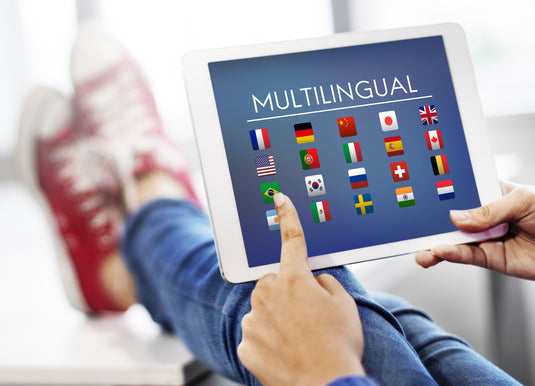For many companies and industries, the COVID 19 pandemic was a dead end from which they could not escape. But online retail in particular boomed, taking advantage of the lockdown, home office, and the like, as evidenced by e-commerce statistics that show impressive growth figures not only for the industry giants, but also for smaller retailers on the Internet. Read on to find out who has benefited most from 2020 and what you can learn from the statistics.
Thanks to Corona: Online retail sales records shattered
2020 was a good year for e-commerce giants Amazon and eBay. While the company founded by Jeff Bezos was able to increase its sales by 38 percent to $386 billion compared to 2019, eBay broke the $10 billion barrier for the first time after turbulent years.
But all eyes were on another company: Shopify. The Canadian e-commerce software developer increased its revenue by a whopping 86 percent year-over-year. Shopify's focus is on creating a solution that allows anyone to set up their own online store with a few clicks of a mouse. While big names like Red Bull and Tesla use Shopify, its target audience is primarily small and medium sized businesses.
A trend is emerging. Of the estimated $10 trillion in e-commerce sales in 2020, $4.2 trillion will come from e-retail. Not only does e-commerce account for a large share of Internet commerce, it is also considered a safe haven for retailers. Despite store closures, in some cases for months, due to the COVID-19 pandemic, global retail sales declined by only three percent, ultimately totaling nearly $24 trillion.
COVID-19: Curse and blessing for e-commerce
For many industries, Corona was a disaster - online commerce notwithstanding. The tourism industry saw a 75 percent drop in online sales due to numerous travel restrictions. Furniture and household goods (-53 percent), electronics (-48 percent) and fashion (-43 percent) also suffered in 2020. However, the fashion sector is still seen as the driving force behind online retail in 2020. Experts predict that the fashion and accessories sector will recover rapidly and break the €1 trillion mark in global online retail sales by 2025.
But e-commerce statistics also show that there is no crisis without winners. In 2020, about one in two online shoppers will have bought some product online for the first time. Food, household goods, toys, and sports equipment - products that are in high demand during the quarantine period - have seen particularly strong growth. Similarly, half of respondents said they would buy more online during the pandemic. In addition, 53 percent of all users would continue to shop online after the pandemic.
The easy options of courier delivery or door-to-door delivery became more popular. Eighty-five percent of users said they would prefer home delivery, according to the United Nations. Only 22 percent would also have their packages delivered to post offices on a regular basis, and 19 percent would also have them delivered to their workplace.
China clearly leads online retail
Unsurprisingly, it is the major economies that lead the way in terms of e-retail sales. China leads the world with $672 billion in sales, followed by the US with $340 billion. The UK, Japan and Germany follow in second place. However, Russia and Brazil, countries with comparatively low purchasing power, are also in the top 10.
Despite a population of over 1.3 billion, India is missing from the ranking of the strongest e-commerce markets. But that could soon change. According to estimates by the India Brand Equity Foundation, the Indian market is expected to reach $200 billion in annual sales by 2026. One of the reasons for this is the Indian government's Digital India program. This program aims to massively promote the digitization and expansion of the Internet in the South Asian country. Today, 97 percent of Internet access is via mobile devices. India is one of the most important growth markets for e-commerce.
In Europe, the UK and Germany remain the most important markets for online retail. On the one hand, the size of the population means that these two countries contribute $99 billion and $73 billion respectively to global online sales. At the same time, 48.6 million people in the UK regularly shop online, with a comparatively high 14.5 percent of retail sales generated online.
On the other hand, the success of e-commerce in the UK and Germany can also be attributed to Amazon. The mail-order company, which started out as an online bookstore, has been operating in both countries since 1998. In Germany, Amazon got off to an easy start, eventually buying the then German market leader Telebuch.de for tens of millions of dollars and taking over its operations.
2020 will be a record year for Amazon
When you think of e-commerce, you automatically think of Amazon. After all, the giant mail-order company is a symbol of online shopping. What Google is to the search engine industry, Amazon is trying to be to online shopping. So it is no wonder that Amazon is flourishing, especially in 2020. However, the success of the platform is not only due to its own products, warehouses and employees.
Amazon's marketplace has been open to third-party sellers since 2000 - in more than 130 countries. Many smaller retailers who were hit hard by the shutdown switched to Amazon as the most lucrative sales platform. Today, one out of every two products sold on Amazon comes from small and medium-sized businesses.
The best time to observe the role retailers play in Amazon's success is Prime Day. The event, which is Amazon's version of Black Friday and stands for massive discounts on the platform, took place on October 13 and 14. In total, Amazon made ten billion dollars on those two days. However, a full $3.5 billion was spent on products from small and medium-sized businesses.
This success makes Amazon by far the most valuable Internet-based company in the world. With a market value of just under $1.6 trillion, it far outstrips its Chinese counterpart Alibaba (around $777 billion). It is followed at a considerable distance by Prosus, which holds stakes in Tencent and Delivery Hero, Shopify and JD.com, the number two in Chinese online retail.
The success of the platform is not only reflected in the value of the company. Amazon 2020 has also become the most downloaded shopping app on smartphones and tablets. The company has 169 million downloads, a quarter of which come from U.S. users alone. Smartphone users are already an important target group for e-commerce. By 2020, 55.4 percent of online purchases will be made from smartphones. Shopping apps are more popular among iOS users than Android users.
But Amazon is also facing new challenges. While its revenue and enterprise value will rise sharply in 2020, its market share will fall. While Amazon was responsible for 49.4 percent of e-retail sales in 2019, its share was only 31.4 percent in 2020. More and more competitors are able to catch up and capture the existing growth potential. In this context, user data and surveys show where the biggest challenges and opportunities lie for e-commerce companies.
Why ecommerce merchants are leaving cash behind
Not every item that ends up in the shopping cart is actually purchased. Various studies have found that the rate of unpurchased products is astonishingly high, ranging from 50 to 80 percent. The American Customer Satisfaction Index report provides a clear indication of the cause: since 2013, online shoppers have never been more dissatisfied, with 53 percent of shoppers surveyed by Bloomreach stating that a bad shopping experience has already caused them to stop ordering from a seller.
So what are the areas that shopping portals need to address in order to keep their customers? The most important is additional costs. Excessive fees for shipping and taxes cause 49 percent of users to abandon a purchase. At the same time, 50 percent say they would pay more for a better online shopping experience.
Price psychology is therefore a key factor. However, it is the other points that reveal what e-commerce providers really need to work on. The need to create an account is a deterrent for 24 percent of users. Excessively long delivery times are a no-go for 19 percent, and 18 percent are also fed up with overly complicated ordering and payment processes. If store operators work on the "small" issues and improve the shopping experience, the main problem of high incremental costs may disappear in the long run.
How new generations are changing the world of shopping
Online shopping is a phenomenon that has been driven by young people in recent years. In the U.S. alone, some 86 percent of so-called millennials shop online. The older the cohort, the lower the percentage of online shoppers. However, the market is increasingly being driven by the younger Generation Z, people born before 1997.
Young people spend much of their online time on social media. The networks offer interesting opportunities to link profiles with online stores - or to let their users shop directly on the site. For example, 58 percent of Gen Z users have ordered items via social media, with Instagram being the preferred platform. By contrast, the percentage of Millennials who shop via social media is only 45 percent. If you want to reach the younger generation, you can't ignore social media integration in your store.
However, a broad social media presence is not just about making it easier to order. Research and comparison still play an important role in online shopping. Three out of four people compare products on Facebook, Instagram and similar sites, as well as on marketplaces like Amazon and eBay. Being active everywhere increases your chances of making a sale. According to Shopify, advertising and listing on multiple platforms combined with excellent SEO can increase sales by up to 190 percent.
Exciting developments around the world
E-commerce isn't just happening in the U.S. and Canada, Central Europe and China. Online shopping is a global phenomenon. Sales are also growing in South America, Africa and Southeast Asia. Thanks to the high penetration of smartphones and the young average age in the southern hemisphere, growth rates could reach unprecedented levels.
In countries like the U.S., online retail sales are expected to increase dramatically by 2020. But the real winner is South America. On the continent, e-commerce grew by a staggering 36.7 percent year-over-year in the first year of the Corona pandemic, well above the global average of 27.6 percent. Brazil currently ranks tenth among the largest e-commerce nations.
But online retail is also strong in Malaysia, for example. Some 83 percent of Malaysia's young and steadily growing user base have already placed an order online, and the figure is similar in neighboring Singapore at 80 percent. In the Philippines, one of the world's largest countries with a population of 110 million, around 80 percent of Internet users shop online. In the archipelago, Internet shopping is popular even among the younger generation. The largest group of online shoppers is between the ages of 35 and 44.
Why is this important? E-commerce is becoming a global phenomenon. Ordering goods in one's own country is becoming less important. According to a Forbes survey, 55 percent of users will have purchased a product from another country by 2020. Revenue from cross-border sales increased by 21 percent over the previous year. Falling tariff barriers and faster delivery times are making it more attractive to order across national borders.
If you want to be successful online, you cannot ignore the largest and fastest growing markets. This is the only way to benefit from the rapid growth in global e-commerce sales. The pandemic was seen as a boost for many companies and industries, but they were already growing strongly before 2020. Given the still small share of online sales in many countries and the numerous opportunities, extreme growth in online sales is more than likely to continue.





